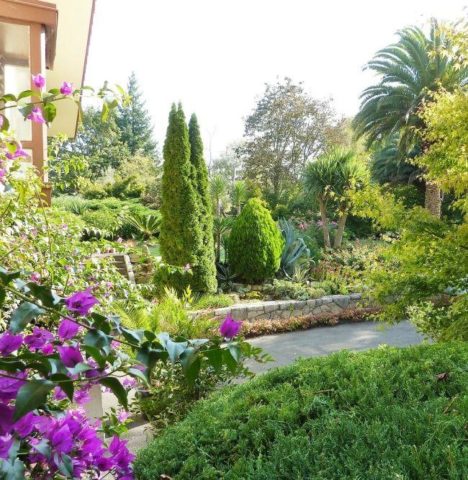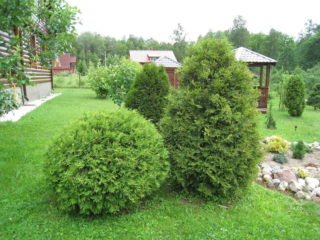Content
Thuja Holmstrup, also known as Thuja occidentalis Holmstrup, is a favorite ornamental perennial of the Conifer family for many gardeners. This plant has gained its popularity for a reason: the ephedra is not picky about growing conditions, and its crown has an interesting conical shape that can decorate any garden or summer cottage.
Description of Thuja Holmstrup
Based on the description, Thuja occidentalis Holmstrup is an evergreen plant, similar to what can be seen in the photo. Although the height of adult specimens is 3 - 4 m, with a diameter of 1 - 1.5 m, these ornamental trees are characterized by low growth rates. To reach its maximum size, Thuja Holmstrup will need at least 10 - 12 years. The average age of this plant is close to 200 years.
Like most conifers, throughout the year Thuja Holmstrup retains the dark green color of the crown, which is characterized by density and has a symmetrical cone-shaped shape that can be preserved even in the absence of regular decorative pruning. The highly branched shoots are covered with soft scaly needles that do not fall off in winter. The root system of the plant is located in the upper layers of the soil and is compact.
Thanks to its excellent aesthetic qualities and ease of care, thuja variety Holmstrup is a favorite of many gardeners when creating exquisite landscape compositions.
The use of thuja Holmstrup in landscape design
The characteristics of thuja occidentalis Holmstrup have been highly appreciated by landscape design masters in many countries around the world. This plant shows itself equally brightly in single and group plantings. In addition, dark green thuja can serve as an excellent background for other ornamental crops
Holmstrup thujas planted separately are used for landscaping urban landscapes, as well as for designing rockeries, alpine slides and lawns, as in the photo below.
A group of trees arranged in a row or forming a hedge, in turn, is perfect for creating natural fences that separate the functional areas of the garden. They are also used to mark the boundaries of a site, planted along the perimeter of the territory. This placement, in addition to being decorative, has another goal - air purification, since Thuja Holmstrup traps exhaust and heavy metals. For the same reason, it is located near industrial buildings and highways.
A few more photos with examples of the use of thuja Holmstrup in landscape design:
Peculiarities of reproduction of Western Thuja Holmstrup
Another advantage of this plant is its resistance to external conditions and rapid establishment. According to reviews, Thuja Holmstrup can be grown without much effort even at home. The easiest way to do this is by cutting the plant. Some gardeners practice propagation of thuja Holmstrup by seeds, but in this case the chance that the characteristics of the variety will be preserved is very low.
Landing rules
Although Thuja Holmstrup cannot be called a whimsical plant, to ensure healthy growth and maintain its decorative characteristics, it is worth familiarizing yourself with the basic planting rules.
Recommended timing
The optimal time for planting thuja Holmstrup is considered to be mid-spring, when the likelihood of return frosts is minimal. Although this plant can boast of fairly high frost resistance, it should be planted in open ground no earlier than the end of April, so that the soil has time to warm up and the root system is not damaged. Dry, warm autumn is also suitable for planting thuja, but in this case the seedlings must be covered for the winter.
Site selection and soil preparation
The location for planting the western thuja variety Homestrup should also be chosen with the utmost care. It grows especially well in sunny places that are not exposed to drafts, but the culture also does quite well in slightly shaded areas.Too strong a shadow leads to the fact that the thuja needles begin to turn pale and the crown loses its density. Lack of sun also affects the health of the plant: its immunity weakens, and the tree becomes more susceptible to fungal diseases.
It is advisable to select light and loose soils for thuja Holmstrup, for example, sandy loam or turf in combination with peat and sand. In dense soil, drainage from 15 to 20 cm thick should be used to prevent stagnation of water and rotting of the roots.
Landing algorithm
Planting of thuja western Holmstrup is carried out, guided by the following description:
- Before planting, a soil mixture of sand, low-lying peat and leaf soil is prepared for the plant in proportions of 1:1:2.
- The planting hole is made slightly larger than the root part of the thuja Holstrup. Its approximate size should be 80x80 cm.
- It would be a good idea to place a drainage layer of broken brick or crushed stone in the recess.
- For intensive growth, nitrogen-phosphorus fertilizer is added to the soil at the bottom of the planting hole.
- Before planting, the seedling is generously watered.
- If the seedling has a closed root system, that is, a ball of earth around the roots is preserved, it is placed in a planting place, and then sprinkled with soil mixture so that the root collar is near the surface, and the soil around the plant is compacted.
- If a young thuja has an open root system, first prepare an elevation of soil in the center of the hole, and then place the tree on it, carefully straightening the roots. At the end of the procedure, the soil is compacted, without filling the root collar.
After planting, the plant is abundantly saturated with water, and the soil within the tree trunk circle is mulched with sawdust, peat or mowed grass.
Rules for growing and care
Young Thuja Holmstrup trees require periodic weeding and loosening. When carrying out these procedures, it is worth remembering that the root system of such conifers is located close to the surface of the soil, and therefore when digging the soil deeper than 10 cm, it can be accidentally injured.
The rest of the care when growing these plants includes timely watering, regular fertilizing and pruning.
Watering schedule
The drought resistance of the western thuja variety Holmstrup allows it to survive for a long time with a small amount of water, however, a prolonged lack of liquid has a negative impact on the appearance of the plant. In order for the thuja to please the eye all year round, it is necessary to water it at least 1 - 2 times a week, allocating 10 liters of water per tree. During drought periods, watering is increased to 20 liters - 3 times a week.
Along with watering, you can sprinkle the plant 1 - 2 times a week. This procedure will not only refresh the crown of the conifer, but will also have a beneficial effect on its growth. But it is worth keeping in mind that it is carried out only on healthy thujas. Trees infected with fungal infections are not recommended to be moistened in this way.
Top dressing
Thuja Holmstrup is fertilized once a year, usually in the spring, in April - May.Universal mineral complexes for conifers, such as Kemira-Universal or nitroammofoska, are used as top dressing, using 50 - 60 g of the composition per 1 sq. m. m of territory.
Trimming
To maintain the visual appeal of the thuja Holmstrup, it must be pruned from time to time. Sanitary pruning to remove dry and damaged branches can be done every year after winter. Decorative pruning is not required so often: it is enough to trim the plant once every 2-3 years.
A hedge of western thuja Holmstrup, such as the one in the photo above, is formed by cutting the shoots by a third. In the future, to maintain its shape, it is leveled 3 to 5 times a year.
Preparing for winter
Being plants of the third and fourth frost resistance zones, adult specimens of the thuja variety Holmstrup can easily tolerate even severe frosts down to -35 °C, so in central Russia they do not need shelter.
At the same time, young trees do not have such winter hardiness, so in the first couple of winters after planting they must be protected from frost using covering material. For this purpose, agrofibre or burlap is useful, which is used to wrap the crown of plants, leaving a small space between the material and the needles for air circulation. Additionally, you can mulch the thuja tree trunk with spruce branches: this will save it from waterlogging when the snow melts and protect it from rodents.
With the arrival of spring, as soon as the snow melts and the frosts end, the shelter from the thuja Holmstrup is removed. They do this in cloudy weather, and not right away. First, the agrofibre is raised by 1/3 and the plant is left in this form for 5-7 days so that it adapts. After the specified time, the protective material is completely removed.
Pests and diseases
Although Thuja Holmstrup is resistant to most diseases, it is sometimes attacked by certain insects that damage the plant's needles. These include thuja aphids and false scale insects.
Due to their activity, the crown of the tree acquires a yellowish tint and falls off. Various insecticides have proven themselves to be effective against these pests; they must be used to treat the plant twice, maintaining a gap of 7 to 10 days between treatments.
The root system of young thuja Holstrup trees is often encroached upon by the larvae of cockchafers. Having discovered this insect on the site, do not underestimate the danger it can cause: even one larva of the cockchafer can destroy a conifer seedling in 24 hours. You can save plants from this scourge if you water it with a solution based on Imidacloprid.
As for diseases, with proper care they do not threaten thuja Holmstrup trees. However, if the watering schedule has been disrupted, the thuja variety Holmstrup can be affected by fungi, which will cause the branches of the plant to dry out. Regular watering and treating trees three or four times with compounds containing copper will help correct the situation. Similar treatments are carried out every 2 weeks until the condition of the thuja Holmstrup returns to normal.
Conclusion
Thuja Holmstrup definitely deserves the attention that landscape designers and plant growers give her.It is beautiful, compact and looks very impressive in a variety of plant compositions. And most importantly, even novice gardeners can grow it on their own plot.



















